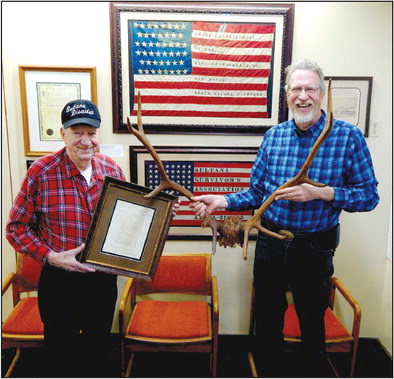Sultana museum adds antlers

Sultana museum adds antlers
Odd but appropriate item a part of disaster’s lore
news@theeveningtimes.com
When visitors to the Sultana Disaster Museum visit the exhibit they will come across an unusual piece of memorabilia — a pair of elk antlers.
So what do a pair of elk antlers have to do with the greatest maritime disaster in U.S. history?
Alot according to Sultana scholar and artifact collector Gene Salecker.
“Elk antlers represented a fast boat — THE fastest boat on the river,” Salecker said. “On the trip prior to the one when the boilers exploded the Sultana had set the record for the fastest trip from New Orleans to St. Louis. So they were awarded the coveted antlers.
“If you were a shipper or a passenger and you wanted a fast trip, to find the fastest boat on the dock all you had to do was look for the one with the elk antlers.
That’s the fastest boat. You would want to get on that one or put your freight on that one.”
The antlers can be seen hanging from the smokestack in the famous last photograph taken of the boat in Helena before it exploded in April 1865.
Salecker presented the museum with a pair of elk antlers for display along with several other newly acquired artifacts.
“They aren’t the real ones,” Salecker said. “But I just think it is an interesting piece for the museum. People will be walking around the museum and ask why do you have those antlers?
Then you give the story and show them the picture.”
The Sultana was a Civil War paddlewheel steamboat that exploded just north of Memphis in the early morning hours of April 27, 1865 and resulted in the deaths of over 1,700 people, mostly Union soldiers who had been held captive and were returning home from the war. The sinking of the Sultana is the greatest maritime disaster in U.S. history.
Marion has a special connection to the disaster as many of its early residents helped rescue the survivors. The remains of the boat are buried under a soybean field in Marion.
The city operates a small museum on Washington Street and is considering building a bigger, permanent museum next to the Woolfolk Library.
Another item Salecker brought on this trip was a handwritten piece of paper from the Northern Line Packet Company from March 1863 showing the rates the steamboat company charged the government to transport sick, discharged, or furloughed soldiers to cities along the Mississippi River from St.
Louis north all the way up to Minneapolis/St. Paul.
“This was written a few months before Vicksburg surrendered before the whole Mississippi River was open,” Salecker said.
“If you were going from St. Louis north to Galena (Illinois) or all the way to LaCrosse (Wisconsin) they are going to charge you a certain rate if you were in cabin with meals or if you were just going to stay on the deck and bring your own food.”
The company charged $10.50 for a cabin or $5 to stay on the deck.
The document is signed by Thomas Griffith, secretary of the Northern Line Packet.
“This is just another good piece of steamboat memorabilia for people to see the shows the cost of travel,” Salecker said. “When the soldiers boarded the Sultana the government was paying $10 for officers and $5 for enlisted men.”
Other new arrivals to the museum include a prisoner of war reunion flag in Columbus, Ohio which was owned by Sultana survivor Albert Norris of the 76th Ohio Infantry, and a knife which was on the Sultana.
Salecker said the knife or file was salvaged from the scrap metal pile which was left behind on Hen Island after divers recovered one of the boat’s boilers.
It hung inside GAR (Grand Army of the Republic) Post 117 in Marion, Ohio where Sultana survivor William Fies was the adjutant.
“When the Sultana exploded they sent divers down to see what may have caused the explosion,” Salecker said. “They did recover one of the boilers.
The other three had completely disintegrated. They brought it up to see whether it had been scorched or possibly had low water. A lot of stuff was brought up and just thrown on a pile and left on the island if they didn’t need it. So I am 99.9 percent certain is was
on the Sultana.”
Salecker said although the boat sank over 150 years ago, there are still various artifacts connected with the Sultana out there in private collections or in the hands of descendants that have stories to tell.
He buys artifacts whenever they turn up on auction sites and also at Civil War swap meets.
The flag and the knife were purchased from a collector in Ohio who has been buying Civil War items since the 1960s but now is getting older and starting to sell off his collection. Another collector in Michigan that he knows of has about half a dozen Sultana related items.
“I have no idea what is out there,” Salecker said. “I’m always on the lookout for reunion ribbons, curio boxes, personal items the soldiers may have had, and reunion items. A lot of dealers know I am the Sultana man and will save things for me.”
Salecker is also working on a model of the Sultana — similar in size to the one currently on display in the museum in Marion — which will show what the boat looked like after the explosion.
“It has now moved in to my workshop,” Salecker said. “I have to strip the paint because they had the bottom painted black. But when it is finished it will show the collapsed decks, the fallen smokestacks, and the damage to the paddlewheels.”
By Mark Randall


Share